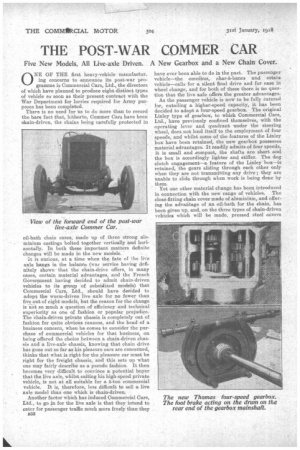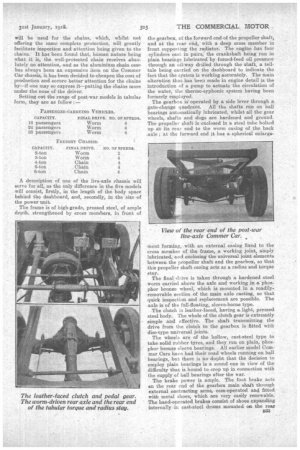THE POST-WAR COMMER CAR
Page 10

Page 11

Page 12

If you've noticed an error in this article please click here to report it so we can fix it.
Five New Models, All Live-axle Driven. A New Gearbox and a New Chain Cover.
ONE OF THE first heavy-vehicle manufactur_ ing concerns to announce its post-war programrae is Commercial Cars, Ltd., the directors of which have planned to produce eight distinct types of vehicle so soon as their present contract with the War Department for lorries required for Army purposes has been completed.
There is no need for us to do more than to record the bare fact that, hitherto, Commer Cars have been okain-driven. the chains being carefully protected in oil-bath chain eases, made up of three strong aluminium castings bolted together vertically and horizontally. In both these important matters definite changes will be made in the new models.
it is curious, at a time when the fate of the live axle hangs in the balance (war service having definitely shownthat the chain-drive offers, in many cases, certain material advantages, and the French Government having decided to admit chain-driven vehicles to its group of subsidized models) that Commercial Cars, Ltd., should have decided to adopt the worm-driven live axle for no fewer than five out of eight models, but the reason for the change is not so much a question of efficiency and technical superiority as one of fashion or popular prejudice. The chain-driven private chassis is completely out of fashion for quite obvious reasons, and the head of a business concern, when he comes to consider the purchase of commercial vehicles for that business, on being offered the choice between a chain-driven chassis and a live-axle chassis, knowing that chain drive has gone out so far as his pleasure cars are concerned, thinks that what is right for the pleasure car must be right for the freight chassis, and this sets up what one may fairly describe as a pseudo fashion. It then becomes very difficult to convince a potential buyer that the live axle, whilst suiting his high-speed private vehicle, is not at all suitable for a 5-ton commercial vehicle. It is, therefore, less difficult to sell a live axle model than one which is chain-driven.
Another factor which has induced Commercial Cars, Ltd., to go n for the live axle is that they intend to cater for passenger traffic much more freely than they 332 have ever been able to do in the past. The passenger vehicle—the omnibus, char-a-hence and estate vehicle—calls for a silent final drive and for ease in wheel change, and for both of these there is no question that the live axle offers the greater advantages.
As the passenger vehicle is now to be fully catered for, entailing a higher-speed capacity, it has been decided to adopt a four-speed gearbox. The original Linley type of gearbox, to which Commercial Cars, Ltd., have previously confined themselves, with the operating lever and quadrant under the steering wheel, does not lend itself to the employment of four speeds, and whilst some of the features of the Linley box have been retained, the new gearbox possesses material advantages. It readily admits of four speeds, it is small and compact, the shafts are short and, the box is accordingly lighter and stiffer. The dog clutch •engagement—a feature of the Linley 'box—is retained, the gears sliding through each other only when they are not transmitting any drive ; they are unable to slide through when work is being done by them.
Yet one other material change has been introduced in connection with the new range of vehicles. The close-fitting eham cover made of aluminium, and offering the advantage of an oil-bath for the chain, has been given up, and, on the three types of chain-driven vehicles which will be made, pressed steel covers will be used for the chains, which, whilst not offering the same complete protection, will greatly facilitate inspection and attention being given to the chains. It has been found that, human nature being what it is, the well-protected chain receives absolutely no attention, and as the aluminium chain case has always been an expensive item on the Cornmer Car chassis, it has been decided to cheapen the cost of production and secure better attention for the chains by—if one may so express it—putting the chains more under the nose of the driver.
Setting out the range of post-war models in tabular form, they are as follow :— A description of one of the live-axle chassis will serve for all, as the only difference in the five models will consist, firstly, in the length of the body space behind the dashboard, and, secondly, in the size of the power unit.
The frame is of high-grade, pressed steel, of ample depth, strengthened by cross members, in front of the gearbox, at the forward end of the propeller shaft, and at the rear end, with a deep cross member in front supporting the radiator. The engine has four cylinders oast in pairs, the crankshaft being run in plain bearings lubricated by-forced-feed oil pressure through an oil-way drilled through the shaft, a telltale being carried on the dashboard to indicate the fact that the system is working accurately. The main alteration that has been made in engine detail is the introduction of a pump to actuate the circulation of the water, the thermo-syphonic system having been formerly employed.
The gearbox is operated by a side lever through a gate-change quadrant. All the shafts run on ball bearings automatically lubricated, whilst all the gear wheels, shafts and dogs are hardened and ground. The propeller shaft is enclosed in a steel tube bolted up at its rear end to the worm casing of the back axle ; at the forward end it has a spherical enlarge ment forming, with an external casing fixed to the cross member of the frame, a working joint, amply lubricated, and enclosing the universal joint elements between the propeller shaft and the gearbox, so that this propeller shaft casing acts as a radius and torque stay.
The final -drive is taken through a hardened steel worm carried above the axle and working in a phosphor bronze wheel, which is mounted in a readilyremovable section of the main axle casting, so that quick inspection and replacement are possible. The axle is of the full-floating, sleeve-borne type.
The clutch is leather-faced, having a light, pressed steel body. The whole of the clutch gear is extremely simple and effective. The shaft transmitting the drive from the clutch to the gearbox is fitted with disc-type universal joints.
The wheels are of the hollow, cast-steel type to take solid rubber tyres, and they run on plain, phosphor bronze sleeve bearings. All earlier model Cornmar Cars have had their road wheels running on ball bearings, but there is no doubt that the decision to employ plain bearings is a sound one in view of the difficulty that is bound to crop up in connection with the supply of ball bearings after the war.
The brake power is ample. The foot brake acts en the rear end of the gearbox main shaft through external contracting arms, cam-operated and fitted The leather-faced clutch and pedal gear. with metal shoes, which are very easily renewable. The worm-driven rear axle and the rear end The hand-operated brakes consist of shoe5 expanding of the tubular torque and radius stay. internally in cast-steel drums mounted on the rear wheels. Metal of atspecial quality is used for the shoes and they are readily renewable. 4 Both brakes are adjustable by hand, and each alone is sufficient to hold a fully-loaded vehicle in either direction on very steep gradients. •
• The control of the engine is effected by a foot accelerator and a hand lever on the steering wheel which controls the throttle, whilst a lever on the steering wheel advances or retards the ignition. A 16gallon petrol tank is axed under the driver's seat The radiator is constructed of gilled tubes with cast aluminium top and bottom water tanks bolted to the tube plates, each part being readily replaceable. On each passenger-carrying vehicle the engine will be provided with an electric starter and a lighting set. A mileage recorder will be fitted to every post-war model.
Our illustrations show certain details of the chassis, one of them giving a general view almost in plan, from which it will be seen that there is a cleanliness of design which distinctly calls or commendation.
One of the post-war 3-tormers has been running on general service at the Luton works for some months, affording the makers an excellent opportunity of watching its behaviour and of noting any weak pOint that may obtrude itself. It is worthy of note that, so far, the vehicle has behaved in a highly-satisfactory manner and that no modifications are intended.
























